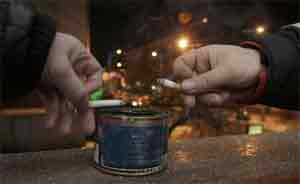Smoking in the entrances to bars increases the presence of nicotine inside
 The protection provided by the smoking ban decreases when people can still smoke outside the venue
The protection provided by the smoking ban decreases when people can still smoke outside the venue
For the first time, a study has analysed the effects of the modification to the Spanish tobacco control law, implemented in 2011 in hospitality venues in Spain. The findings show that smoking on terraces and in the entrances to bars and restaurants increases the concentration of nicotine and particulate matter, which affects clients and hospitality professionals alike.
Smoke in bars would appear to be a thing of the past. However, Spanish scientists have analysed the reduction of nicotine in hospitality venues since the implementation of the 2011 smoking ban, and have found that smoking outside diminishes such protection.
“Having studied hospitality venues in Madrid, Galicia and Catalonia, we found a 90% decrease in the presence of nicotine and particulate matter in suspension, attributable to the regulations that have been in place for the last two years,” explains to SINC Maria José López, the main author of the article and researcher at the Barcelona Public Health Agency (ASPB).
This latest research, published in ‘Nicotine & Tobacco Research’, detected more nicotine and increased presence of particles in bars where clients smoked outside, which acts as a warning to experts on risks associated with incomplete protection for employees and customers.
The results compare the situation in the same establishments before and after the change to the law that took place in January 2011, based on 351 nicotine measurements carried out and a total of 160 samples of particles under 2.5 µ.
The mean concentration of nicotine in the atmosphere in venues with smokers outside was 1.13 µg/cubic meter (m3), while in those where this option is not available there were only 0.41 µg/m3.
The authors also recorded other factors such as the presence of ashtrays, people smoking, and whether there were remnants of cigarette butts in the venue.
An overall decrease
The authors confirm that the 90% reduction in the presence of nicotine and particulate matter corresponds to the findings of similar studies in other European countries, such as Scotland and Ireland.
“The same occurred in Uruguay, where implementation of the law led to a 91% reduction in the presence of secondary smoke in catering venues,” López affirms.
The previous law in 2006 did not protect customers from second-hand smoke exposure, and even created inequalities, allowing hospitality workers to remain exposed to high levels of toxins and carcinogens.
“The 2011 modification of the law represents an extraordinary step forward in the protection of workers’ and clients’ health,” López concludes. Although she insists that “the levels of exposure in outside areas should be studied in more detail and the potential need to establish consumption restrictions in certain places should be considered.”

